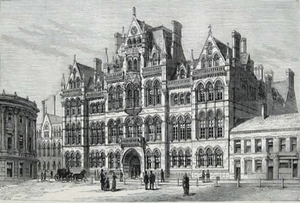Arthur Henry Reginald Buller facts for kids
Quick facts for kids
Arthur Henry Reginald Buller
FRSC FRS
|
|
|---|---|

Arthur Henry Reginald Buller, c.1900
|
|
| Born | 19 August 1874 Moseley, Birmingham, England
|
| Died | 3 July 1944 (aged 69) Winnipeg, Manitoba, Canada
|
| Nationality | English |
| Citizenship | British-Canadian |
| Alma mater |
|
| Awards |
|
| Scientific career | |
| Fields | Mycology, Botany |
| Institutions | University of Birmingham University of Manitoba |
| Doctoral advisor | Robert Hartig, University of Munich and Wilhelm Pfeffer, University of Liepzig |
| Author abbrev. (botany) | Buller |
Arthur Henry Reginald Buller (born August 19, 1874 – died July 3, 1944) was a famous British-Canadian scientist. He was a mycologist, which means he studied fungi like mushrooms and molds. He was also well-known for his research on wheat rust, a disease that affects wheat plants.
Contents
Buller's Education and Early Career
Arthur Buller was born in Moseley, Birmingham, England. He went to Queen's College in Taunton for his early education. Later, he studied at Mason College, which is now known as the University of Birmingham. He earned his Bachelor of Science (B.Sc.) degree there in 1896.
He continued his studies in Germany, getting his Ph.D. from the University of Leipzig and also studying at the University of Munich. The University of Birmingham later gave him another advanced degree, a D.Sc. For a short time, he worked at the Naples Zoological Station. From 1901 to 1904, he taught Botany at the University of Birmingham.
Moving to Canada and Important Work
In 1904, Arthur Buller moved to Canada. He helped start the Botany Department at the University of Manitoba. He became the first Professor of Botany and Geology there. He led the Botany Department until he retired in 1936.
Buller wrote many important books. His book Essays on Wheat (published in 1919) talked about how wheat farming began in Manitoba. It also discussed how new types of wheat, like Marquis wheat, were discovered and used. He also wrote about wild wheat found in Palestine.
His most famous work is a seven-volume series called Researches on Fungi. Six volumes were published between 1909 and 1934. The seventh volume was published after he passed away in 1950. These books are very important for understanding fungi.
Awards and Recognition
Arthur Buller received many honors for his scientific work.
- In 1909, he became a Fellow of the Royal Society of Canada (FRSC). He was even the President of this society in 1927.
- He was also the President of the British Mycological Society in 1914.
- In 1929, he won the Flavelle Medal from the Royal Society of Canada.
- In 1937, he was chosen as a Fellow of the Royal Society (FRS), which is a very high honor for scientists.
- He was also a lifelong member of the Mycological Society of America.
Many universities gave him honorary degrees, including the University of Saskatchewan, University of Calcutta, University of Manitoba, and University of Pennsylvania. The Buller Building at the University of Manitoba, built in 1932, is named after him to honor his contributions.
See Also
 In Spanish: Arthur Henry Reginald Buller para niños
In Spanish: Arthur Henry Reginald Buller para niños


